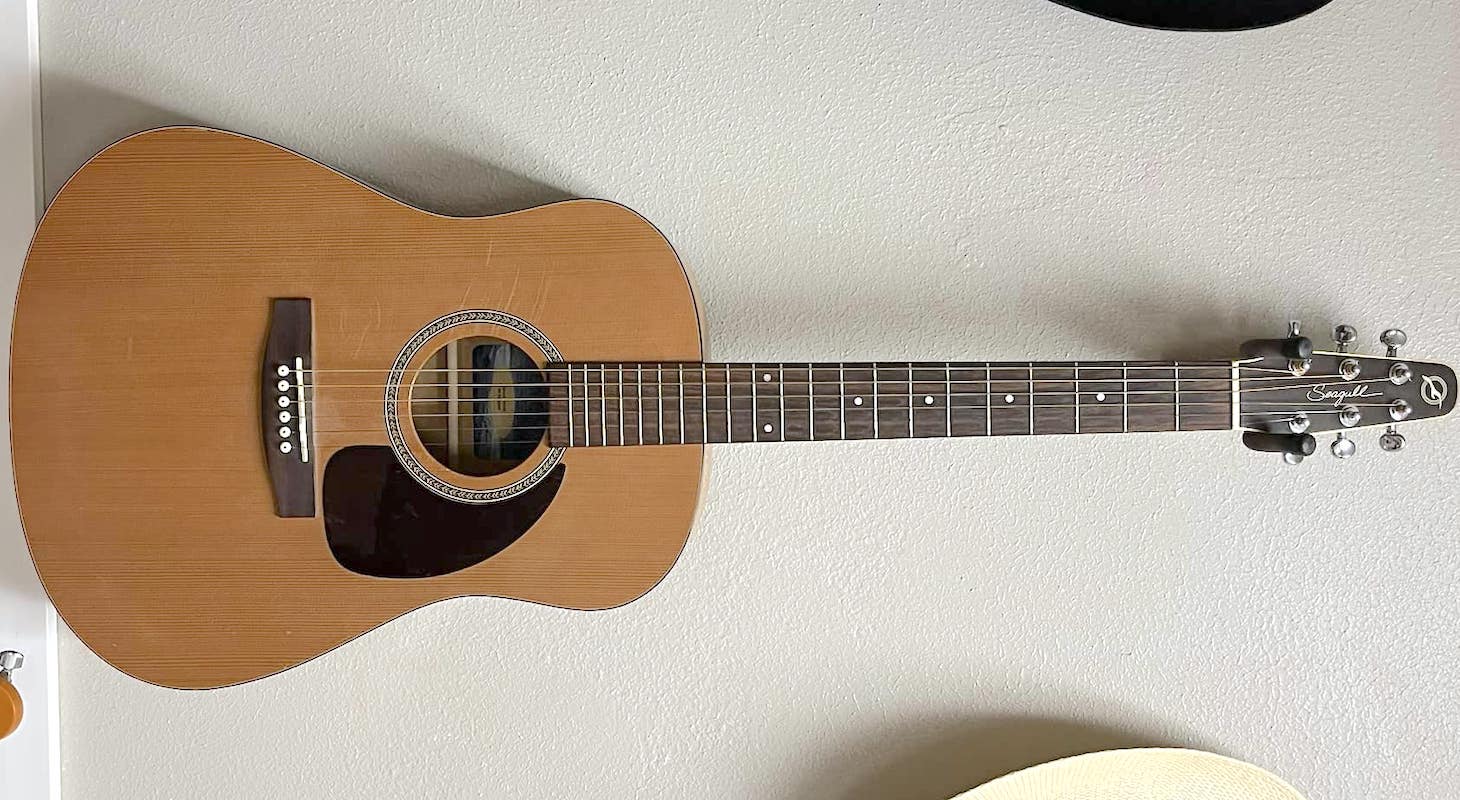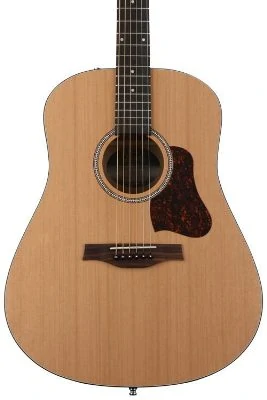Seagull is one of those brands nobody talks about, but we all played. Yes, I remember the first time I had one of these in my hands, probably a decade and a half ago. Moreover, I played an entire acoustic show with one of these that night, filling for a friend.
They sound great, are affordable, and have a matte finish that’s just sexy.
This is my honest review of one of those pearls that have grown hidden from mainstream media. If you’re new to these Canadian wonders, you’re in for a treat.
Let’s jump right in!
Quick Take
Warm cedar tone, great tuning stability, and a chubby, comfy neck make the S6 punch far above its price tag. Think sweet, balanced mids with enough projection to hang with guitars twice the cost.
A Disastrous Night that Ended in a Surprise
One of the best things music has ever given me is my friends. Making music, organizing local tours, playing packed small bars, and sweating your way to the spotlight are things that come with the job description. I always did those surrounded by amazing people.
One of those great moments is dinner before the show with the other bands performing that night. Well, that and making a toast to music before stepping on stage.
That said, let me tell you that cutting lettuce for salad before playing a live show isn’t the best idea for the guitarist (or bass player) in the band. My friend cut his index finger. From his left hand. We called the ambulance, and three Doritos later, he had four stitches.
I spent the rest of the night learning his songs so the band could perform. They played acoustic, and we were the electric band of the night.
He handed me his guitar for practice. Right away, I noticed the fat, almost chubby neck. That thing felt like home, like a baseball bat ready to knock it out of the park. The top was vibrant and allowed me to work dynamics with the pick. When I played louder, things grew, and when I wanted to mellow it down, I’d use my fingers, and the guitar purred instead of screaming.
The shape was kind of odd, like a slightly modified dreadnought. It doesn’t feel as big and boomy when galloping on big, major, open chords. It’s more focused; the whole upper midrange is just killer. The definition is next-level.
I raised my eyes and asked him. “How much did you pay for this thing? It sounds great!”
Well, Seagulls aren’t expensive guitars (the S6 isn’t, at least), but they sound like guitars twice their price.
My healthy, round, and callused fingers, and I played twice that night. Funny enough, I had to dress up to play the acoustic gig. They had matching outfits. I’m 5 feet 5 and he’s 6 feet 10.
I can just say, it was fun. Weird, uncomfortable, but fun.
The Seagull Tone
The whole show went great. The guitar was well-balanced, comfortable, and stable. As you might know, when playing an acoustic show, tuning stability is THE thing to worry about. Chords need to be tight, in tune, and balanced.
I have to tell you that there’s something about the extra-lows of a Martin and the definition of a Taylor that you won’t find anywhere else. That said, this guitar sounds sweet. To describe it in frequencies, I would say that the lower-mids sound round and big, while the higher-mids are tamed and musical.
For example, we played a version of Chris Isaak’s amazing “Wicked Game,” and I played the whole thing with my fingers. The result was so close to velvety that the singer went low on it to an almost whisper.
By the final chorus, I gave my picking hand some movement and grabbed a pick. The result was big but tamed. You don’t have that presence that cuts through you’d get from Taylor or that earthquake-like rumble you get when pushing a Martin.
This sits somewhere right in the middle with enough definition to make it modern and sweet and big enough to fill the room.
Moving Past The Ugly Headstock
The next day, after playing that gig, I went out to try some Seagulls out. I had a lot of fun with it the night before, and my friend said they were affordable. What could go wrong, right? Just a guitar player trying a bunch of acoustics and maybe taking one home.
Well, when I spotted them for the first time walking down the music-store street in my city, I couldn't believe my eyes. I mean, I hadn’t noticed just how ugly the headstock is.

Seagull S6 - Headstock
I know, I know, beauty is subjective. Yet, when you see a headstock that’s this ugly, there’s no room for speculation. I guess it has something to do with the shape of a seagull or because they just want to save some wood. But boy, oh boy, that’s one ugly headstock if you ask me.
Beyond that, Seagull guitars are just great.
I tried an S6 first, the one I had played the night before. I tried it with and without the Fishman PreSys, and the neck is so familiar, soft to the touch, and round that you just feel at home with it immediately. Also, the mellow, sweet, and familiar tone of the fretboard’s rosewood made it more familiar still.
I heard a little snap, especially on the higher registers, and I wasn’t surprised to find out the neck is made of silver leaf maple. That and the 25 ½” scale are a combination that enhances the upper mids. Since the cedar doesn’t behave like spruce (it’s a much darker, sweeter, mellower wood type), the guitar is very balanced.
One thing you must know, though, is that the wild cherry back and sides are 3-ply laminated but finished with a veneer on top. That means the beautiful dark lines you see on the back aren’t real. They’re an HD image of a beautiful, sexy, dark back and sides printed and then put on the back of your guitar. Much like the flame maple top of an Epiphone Les Paul.
It’s very well done; you’d need a magnifying glass to spot it. Yet, it’s my job to tell you. Well, I don’t want to be the Grinch here either; it has absolutely no impact on the tone or performance, it’s just one of those things guitar nerds have in the back of our heads.
Finally, before leaving the store empty-handed (I can’t move past the headstock, sorry, not sorry), I tried a competitor’s guitar with a nice headstock. Seagull is owned by Godin, but the parent company makes Synth-equipped guitars, so I couldn’t compare any of them against it.
I picked up a Guild DS-240 acoustic with a slope shoulder (kind of a J-45 lookalike) that cost exactly what the Seagull did.
I wanted to like it so I could take home an acoustic, but I have to tell you, after hearing the Seagull and the balanced, sweet sound of the cedar top, the good-old spruce–mahogany combination didn’t quite make it for me.
Don’t get me wrong, the Guild is beautiful and all, but it’s not quite as unique as the Seagull. It’s not an affordable guitar I would add to my collection. The Seagull, on the other hand, if it had a different headstock… I guess I would have one already.
That’s the thing with some guitars, you know? It’s those little imperfections and weird little things that make us fall in love with them. Or not.
Local Cedar: Seagull’s Secret

Seagull S6 Original (Cedar)
Let’s get technical for a second here, shall we? Because after not buying that Seagull, I went deep into the topic. I needed to find out what made this guitar such a great-sounding instrument.
The first thing I learned and broke my heart was that the ugly-looking headstock works, making the guitar stay in tune better. I hope other guitar manufacturers never learn that trick, and this doesn’t become a thing.
The second thing I learned was that the entire secret is the locally sourced (with sustainability in mind) cedar. The guitar is manufactured entirely in Canada, so wood doesn’t have to travel halfway around the world, which gives these guitars that mellow, warm, very-responsive element.
Yes, the secret is in that solid cedar top.
With the Seagull S6, you feel at home and, at the same time, find different responses when playing known moves.
Other Cedar-Top Guitars
Since I found out about cedar’s tone properties, I played other guitars with that wood on a solid top. I wasn’t surprised to find three great upcoming brands making cedar-top acoustics. The ones I tried and liked are:
- Eastman Guitars AC122-2CE Deluxe Grand Auditorium
- Alvarez AEG99ce
- Takamine GD20CE-NS
- Schecter Orleans Studio
- Breedlove Organic Solo Pro Concert CE
Do you want more good news? Well, all those guitars are below the thousand-dollar mark. So, there’s hope beyond the headstock, friends of mine.
There’s hope beyond the headstock.
My Verdict
It doesn’t happen every day that you play a guitar, and the tone, feel, and response stay with you until the next day. It’s even less common that the feeling comes from an instrument you can afford. Even more rare is having the drive to go try one.
Well, all of that happened to me with the S6. In my opinion, it’s one of the best-sounding and playing guitars in its category. For that price, it’s very hard to find any competition.
Also, the cedar top gives it a distinct timbre that matches the body design and the wood choices. All of that, combined with a chubby neck, satin finish, and a slightly less-boomy body, makes it a terrific guitar for beginners, amateurs, and professionals.
It doesn’t sound like a top-shelf Martin, Taylor, or Gibson, but it sounds outstanding for the price tag.
So, if you can make it past one of the ugliest headstocks music history has ever given mankind, you owe it to yourself to try a Seagull S6 today.
Supreme Value!
One of the best-sounding guitars in its price range — warm, balanced, and responsive, with a cedar top that sings. A fantastic choice for players who value tone over looks (yes, that headstock).

